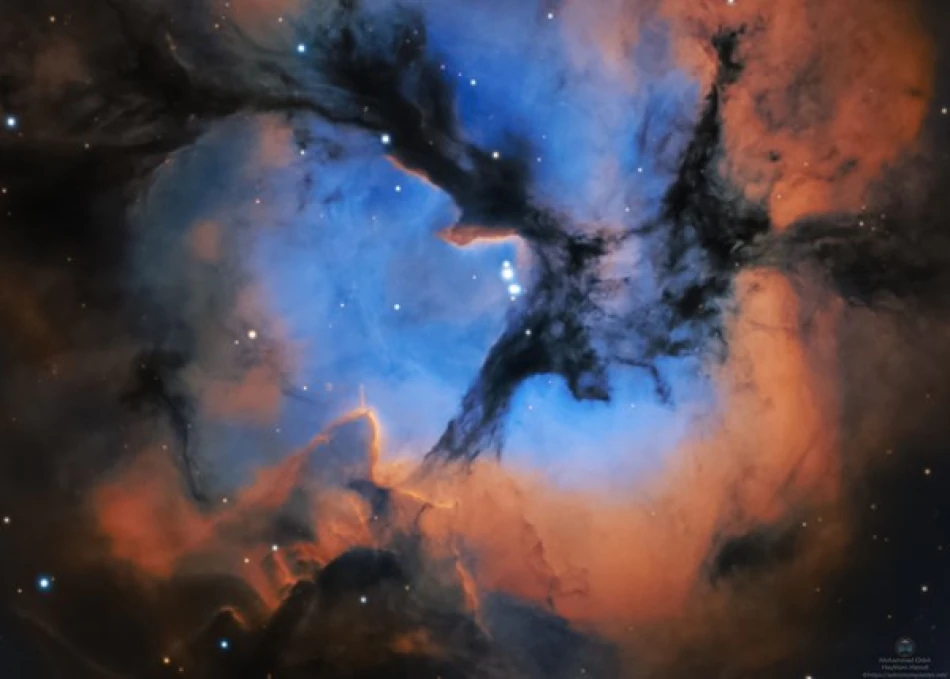
Newly Born Star Captured in Stunning Orion Nebula Timelapse by Astronomical Observatory
Abu Dhabi Desert Observatory Captures Stunning 11-Hour Portrait of Star-Forming Trifid Nebula
The Al Khatam Astronomical Observatory in Abu Dhabi's desert has successfully captured a breathtaking image of the Trifid Nebula, a stellar nursery located 4,100 light-years from Earth. The achievement required 11 continuous hours of imaging and 213 individual photographs, demonstrating the UAE's growing capabilities in advanced astronomical research and positioning the nation as a serious player in space science alongside its ambitious Mars and lunar missions.
A Cosmic Laboratory 42 Light-Years Wide
The Trifid Nebula, officially designated M20, spans approximately 42 light-years in diameter within the constellation Sagittarius. Its distinctive name derives from the three dark dust lanes that appear to divide the nebula into separate sections, creating one of summer's most recognizable deep-sky objects for astronomers worldwide.
What makes this particular image remarkable is its capture of active star formation in real-time. The observatory's equipment revealed a stellar fountain extending roughly three-quarters of a light-year from the nebula's core, appearing as horn-like projections of superheated gas being expelled by a newly formed star.
Technical Excellence in Challenging Conditions
The imaging process showcased sophisticated astrophotography techniques, utilizing a 14-inch telescope equipped with a monochrome camera. Despite operating in Bortle 6 light pollution conditions—far from ideal for deep-sky imaging—the observatory team successfully gathered data across multiple wavelengths.
The final composite image combines 76 hydrogen-alpha exposures (3.8 hours), 55 oxygen III frames (2.8 hours), and 82 sulfur II captures (4.1 hours). This narrowband approach allows astronomers to penetrate cosmic dust and reveal the chemical composition of stellar nurseries, providing insights into how stars and planetary systems form.
UAE's Strategic Investment in Space Science
This achievement reflects the UAE's broader commitment to establishing itself as a regional hub for scientific research and technology. The successful imaging of the Trifid Nebula demonstrates capabilities that extend beyond the country's headline-grabbing Mars Hope mission and planned lunar rover project.
Unlike many Gulf states that focus primarily on oil-based economies, the UAE has consistently invested in knowledge-based industries, including astronomy and space technology. The Al Khatam Observatory's work provides valuable training grounds for Emirati scientists and engineers while contributing meaningful data to the global astronomical community.
Scientific Value Beyond Beautiful Images
Star-forming regions like the Trifid Nebula serve as natural laboratories for understanding stellar evolution and the chemical processes that create the building blocks of planets and life itself. The detailed capture of the stellar fountain phenomenon provides data on how massive young stars influence their surrounding environment through powerful stellar winds and radiation.
This type of long-duration, multi-filter imaging contributes to databases used by researchers worldwide to study star formation rates, nebular chemistry, and the lifecycle of interstellar matter. For a relatively young astronomical program, the UAE's ability to produce research-quality images represents significant progress in building indigenous scientific capabilities.
Regional Leadership in Space Technology
The successful Trifid Nebula imaging places the UAE alongside established astronomical powers and demonstrates practical applications of the country's space technology investments. As regional competition intensifies in space exploration—with Saudi Arabia, Turkey, and Israel all pursuing ambitious programs—the UAE's consistent focus on both robotic missions and ground-based research provides a balanced approach to space science development.
The 11-hour imaging session also showcases operational capabilities essential for future deep-space missions, where precise tracking, data collection, and image processing become critical for mission success.
Most Viewed News

 Layla Al Mansoori
Layla Al Mansoori






